Finishing the installation of electrics in the house, it's time to think about how safety will be respected. If electrical tape was previously used, now a convenient heat shrinkage for wires is popular. Means for laying electrical cables are divided into several types, differing in individual characteristics.
- General information and scope
- Types of heat shrink tubing
- Manufacturing material
- Installation principle
- Shell thickness
- Properties of heat shrinkable products
- Characteristics
- Marking
- How to choose the right diameter
- How to use heat shrink for wires
- Preparatory stage
- Installing a heat shrink tube with your own hands
General information and scope
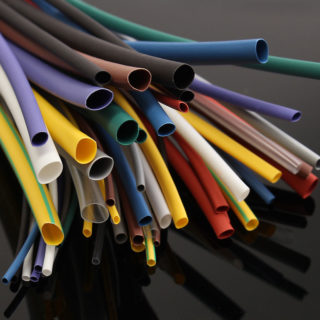
The thermotube for wires is made of polymer with the addition of a certain chemical composition. It corresponds to GOST 17675-87 and GOST 19034-82 and is used in practice exclusively for electrical insulation. The device is stored for a long time, is able to acquire the desired shape during heat treatment. For example, when the material put on the conductor is heated, it narrows, creating a tightness at the switching points. Also, heat shrink tubing can be used in such cases:
- protection of electricians in non-standard conditions;
- strong connection on moving mechanisms that are subject to vibration;
- in conditions of increased dampness;
- for insulation of electrical contacts in the car.
Each product has its own marking, which identifies belonging to a particular type of operation. Many materials are sold ready-made in a kit.
Types of heat shrink tubing
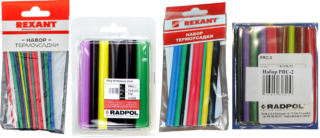
Thermal tubes for insulating wires are divided into several groups, which distinguish them according to their parameters:
- material of manufacture;
- wiring principle;
- shell thickness.
Each of the options is suitable for specific purposes, therefore, when choosing for electrical installation, these features must be taken into account.
Manufacturing material
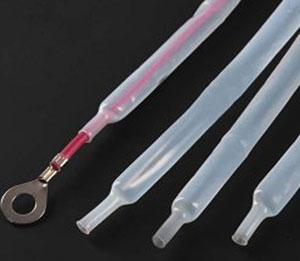
The group should include specimens that are suitable for reliable insulation of household electrical networks.
- Polyolphin insulating tube for wires is considered one of the most common. Possesses high strength, created by radiation and chemical treatment. Operated at temperatures from 50 to 175 degrees.
- Synthetic rubber is resistant to temperatures up to 175 degrees, withstands the influence of fuels and lubricants.
- Polyester. Such tubes are characterized by ultra-thin sheaths, while they have a large diameter and are suitable for insulating a whole coil of cables.
- Thermoplastic PVC. It has excellent insulation quality, but it is not able to withstand temperatures above 80 degrees.
- Silicone heat shrinkable wire connectors. The material is non-toxic, does not conduct electricity. It can deform only when exposed to chemical solutions.
- Fluoroplastic. Such a product is considered one of the most expensive, as it is manufactured using a complex technology. Differs in ideal performance and versatility.
- Connector. It is a small piece of tube with a built-in connection mechanism.
PVC insulation has practically supplanted other means of protecting electrical connections. Therefore, the products are improved annually and the demand for them increases.
Installation principle
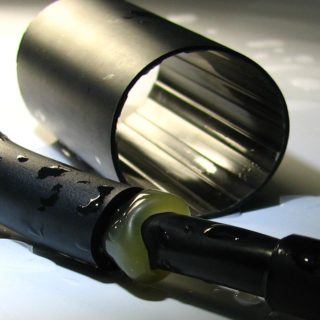
According to the method of use, heat-shrinkable products are divided into three types: with glue, without it, and options with longitudinal sealing.
Glue pipes for wire insulation are materials that are filled with a special sealant that creates additional strength after curing.
Glueless devices are put on the wire connection and warmed up, due to which they create sufficient density. This is what they keep tightness.
Instances with longitudinal sealing are heat-shrinkable tape for wires, which includes batyl-rubber mastic. When it is heated, the composition expands and the space between the conductors is filled with it.
Shell thickness
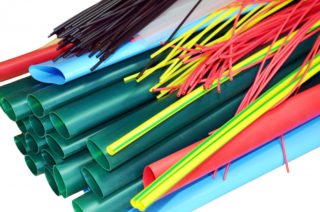
According to this parameter, heat shrink tubes are:
- thick-walled;
- thin-walled;
- medium thickness options.
All these tools are equally used at the final stage of electrical installation and are distinguished by their efficiency.
Properties of heat shrinkable products
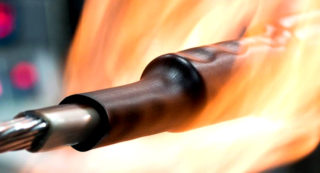
In the process of use, heat shrinkable tubes show their individual properties, which can be estimated due to the presence of thermopolymers in the composition. For example, when exposed to high temperature on the worn heat shrinkage on the conductor, it is actively and firmly compressed, due to which the quality of the tightness will remain high for a long time.
A construction hairdryer or an ordinary lighter can be used to screed the switched sections of electricity. When processing, it is important not to overdo it, otherwise air bubbles will appear inside, due to which the crimp quality will be lost.
When heated, the material does not lose its properties, it is only able to change its shape.
Quality control of electrical wiring can be carried out using a transparent silicone tube.
Characteristics
The main characteristic of this type of insulation is the ability to shrink, which is measured in a ratio of 2: 1, 3: 1, 6: 1, and so on. Heat shrink with wire glue is quite a handy material that creates maximum strength after heat treatment. Such means are exploited to produce protected compounds in difficult places.
Marking
The marking can help you select the correct insulation material. However, it must be read correctly in order to understand what the heat-shrinkable material is suitable for. On the side of the product with a black marker, two diameters are prescribed through a fraction. The first indicates what diameter is set by the manufacturer, the second indicates what it will become after shrinkage at the joint. For example, the values can be written on the insulation: 8/4, 60/25, 10/4 mm.
How to choose the right diameter
In order for the material to easily fit into the joint, you should take an option with a size 10% larger than the insulated area.
At the moment of crimping and warming up, the tube is narrowed by 15-20% of the initial parameter, respectively, the switching becomes reliable and tight.
Do not confuse thermal film for wires with tubing. The first option is used to isolate connections inside household appliances.
How to use heat shrink for wires
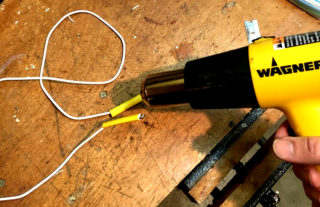
First of all, it is necessary to analyze the features of the cable to which this switching method will be applied. Installation of heat shrinkage is performed in a matter of minutes, without requiring special skills and tools.
Preparatory stage
The preparation process is about choosing the right material and processing it for use. A neat cut must be made before sliding the heat shrink tubing over the insulation. The section should be 10% larger than the area that needs to be insulated.
Installing a heat shrink tube with your own hands
During installation, a piece of the tube is put on one side of the wire, after which a connection is made to the other.Then the product is moved to the right place and is evenly heated with a hairdryer or open fire (using a lighter) from all sides.
It is important not to overdo it, otherwise the heat shrinkage from overheating may deform and slide off the spot. After processing, it is necessary for the insulation to cool down, after which it can be packed in junction boxes.
An important condition when working with heat shrinkable material is compliance with safety measures. All manipulations must be performed with the electricity off.









"An ordinary lighter can be used" - that's all "professionalism" ...